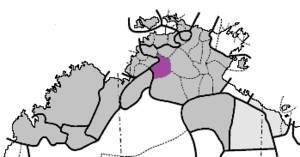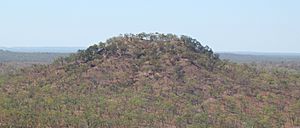Wagiman language facts for kids
Quick facts for kids Wagiman |
||||
|---|---|---|---|---|
| Wageman | ||||
| Region | Pine Creek, Northern Territory, Australia | |||
| Ethnicity | Wagiman | |||
| Native speakers | 11 (2005) | |||
| Language family | ||||
| AIATSIS | N27 | |||

Wagiman (purple), among other non-Pama-Nyungan languages (grey)
|
||||
|
||||
Wagiman, also spelled Wageman, is an Aboriginal Australian language that is almost gone. Only a small number of Wagiman people speak it in and around Pine Creek, in the Katherine area of the Northern Territory.
Wagiman is special to language experts because of its tricky system for changing verbs. It also has a rare type of word called a "coverb" and can turn these coverbs into verbs.
In 1999, people thought Wagiman would disappear within one generation because younger people weren't learning it. The 2011 Australian census counted 30 speakers, but by the 2016 Australian census, there were only 18 speakers left.
Contents
Wagiman: A Unique Language
Where Wagiman is Spoken

Wagiman is a language isolate. This means it's like a language family all by itself, not closely related to other languages around it. People once thought it was part of the Gunwinyguan languages family, which covers a large area in the Northern Territory, but that idea has changed. Wagiman might have a very distant connection to its neighbors, but this is still being studied.
The Wagiman people are Aboriginal Australians. Their traditional lands used to cover hundreds of square kilometers. This land was very fertile and had lots of water. Many Wagiman people used to work on cattle stations in this area, like Claravale and Dorisvale.
The Wagiman language area borders several other language groups. These include Waray to the north, Mayali and Jawoyn to the east, Wardaman and Jaminjung to the south, and Murrinh-Patha to the west.
The main language in the region today is Mayali, a dialect of Bininj Kunwok. Mayali is a strong language with many speakers, and children learn it often. Because of this, many Wagiman people started speaking Mayali instead of teaching Wagiman to their children. Now, only a few elders still speak Wagiman.
Many Wagiman people also speak Kriol. Kriol is a creole language that uses mostly English words. It's often used as a common language in the area. Wagiman people also know some words from other languages like Jaminjung and Wardaman.
Different Ways of Speaking Wagiman
Wagiman speakers know there are two main ways of speaking their language. They call them matjjin norohma (meaning 'light language') and matjjin gunawutjjan (meaning 'heavy language'). The differences between them are small, and people can easily understand each other.
How Wagiman Words Work
Main Word Types: Nouns, Verbs, and Coverbs
In Wagiman, the three most important types of words are verbs, coverbs, and nominals. Nominals are words that act like nouns or adjectives. Wagiman also has many small parts that attach to words (called affixes), as well as exclamations and other small words. Pronouns (like 'I', 'you', 'he') are also part of the nominal group.
Nominals (Nouns and Adjectives)
Wagiman nominals change their endings to show their job in a sentence. For example, they can show who is doing an action (like 'the boy did it') or where something is happening (like 'to the house').
Here are some examples of nominals:
- guda – 'fire' or 'wood'
- wirin – 'tree' or 'stick'
- lagiban – 'man'
- gordal – 'head'
- lagiriny – 'tail'
- manyngardal – 'tongue'
Pronouns (I, You, He/She)
Pronouns in Wagiman also change their form. Here's a simple look at some of them:
| If the pronoun is the main actor | If the pronoun is the one being acted upon | If the pronoun shows ownership | |
|---|---|---|---|
| I (singular) | ngagun | nganung | nganing-gin |
| We (two people) | nginyang | nginyang | nginyang-gin |
| You (singular) | ngigun | ngonggo | ngonggo-gin |
| He/She (singular) | ngonggega (rarely used) | nung | nung-gin |
Sometimes, the words for 'he/she' or 'they' are not used much. Instead, people might use words like 'that' or 'those'. Also, because the verb itself often tells you who is doing the action, you don't always need to say the pronoun.
Verbs (Action Words)
Wagiman has fewer than 50 verbs, and no new ones can be made. They are usually short, one-syllable words that end in a vowel. Wagiman verbs always change to show who is doing the action and when it happened (past, present, future). Some verbs can also take a special ending that means they can't be changed for person or time. These verbs then need another "helper" verb.
Here are some examples of verbs:
- bu-ni – 'hit'
- di-nya – 'come'
- la-ndi – 'throw'
- rinyi-ra – 'fall'
- nanda-yi – 'see'
- yu-nginy – 'be'
Coverbs (Descriptive Action Words)
There are more than 500 coverbs in Wagiman, and more are still being found! Coverbs are much more detailed in meaning than verbs. Verbs have simple meanings like 'be', 'go', or 'come'. Coverbs, however, describe very specific actions. For example:
- barnhbarn-na – 'make footprints'
- lerdongh-nga – 'play (a didgeridoo)'
- murr-ma – 'wade through shallow water using your feet to search for something'
Coverbs cannot change to show who is doing the action, and they can't start a sentence on their own. To be used as the main action in a sentence, they must join with a verb. This creates a "complex predicate," which is like a two-part verb.
Here are some examples of coverbs:
- liri-ma – 'swim'
- dabaley-ma – '(go) around'
- gorrh-ma – 'fish'
- dippart-ta – 'jump'
- wirrnh-na – 'whistle'
Sounds and Spelling
The sounds in Wagiman are typical for languages in northern Australia. It has many consonant sounds, including stops (like 'p', 't', 'k'), nasals (like 'm', 'n'), and other sounds like 'l' and 'r'. It also has a special sound called a glottal stop (like the break in "uh-oh"), which is written as 'h'.
Wagiman has five vowel sounds: 'a', 'e', 'i', 'o', 'u'. These are common in northern Australian languages.
Consonant Sounds
Wagiman has "strong" and "weak" stop sounds. The difference isn't how much air you use (like in English 'p' vs 'b'), but how long you hold the sound.
- Weak stops sound like English 'b', 'd', 'g'.
- Strong stops sound more like English 'p', 't', 'k', but they are held a bit longer. When they are between two vowels, they are written with two letters, like 'pp', 'tt', 'kk'.
At the beginning or end of a word, stops don't have a strong/weak difference. At the start, they are written with 'b', 'd', 'g'. At the end, they are written with 'p', 't', 'k'.
| Sounds made with lips or back of throat | Sounds made with flat part of tongue | Sounds made with tip of tongue | Sounds made in throat | |||
|---|---|---|---|---|---|---|
| Lips | Back of throat | Palate | Alveolar ridge | Curled back tongue | ||
| Weak Stop | p~b | k~g | tj~j | t~d | rt~rd | h |
| Strong Stop | pp | kk | ttj | tt | rtt | |
| Nasal | m | ng | ny | n | rn | |
| Trill | rr | |||||
| Lateral | l | rl | ||||
| Approximant | w | y | r | |||
Vowel Sounds
Wagiman has five vowel sounds: 'a', 'e', 'i', 'o', 'u'. Interestingly, some vowels seem to "harmonize" with others. For example, the 'i' sound can become 'e', and 'u' can become 'o' if the next syllable has an 'e' or 'o' sound.
| Front of mouth | Middle of mouth | Back of mouth | |
|---|---|---|---|
| High tongue | i | u | |
| Mid tongue | e | o | |
| Low tongue | a |
How Sentences are Built
Wagiman is a language that uses prefixes, which are small parts added to the beginning of words. For example, verbs always have prefixes that tell you who is doing the action and when it happened. This is like how English adds '-ed' for past tense, but Wagiman does it at the beginning and in more detail.
Changing Words (Morphology)
Wagiman is a language with rich morphology, meaning words change a lot by adding small parts (morphemes) to them. Each type of word has its own set of these parts.
Verbs
The prefix on a verb tells you about the person and number of the subject (who is doing it) and sometimes the object (who it's happening to). It also tells you the tense (when it happened). There's also a suffix (an ending) on the verb that gives more information about the tense and aspect (how the action unfolds, like if it's finished or ongoing).
Even though there are only a few tense and aspect endings, they can combine with the prefixes to create many different meanings about time and how actions happen.
Nominals
Nominals (nouns and adjectives) also change their endings, but it's less complicated than verbs. These endings are called "case suffixes" and they show the word's role in the sentence. For example, they can show who is doing the action, who is receiving it, where something is, or if something is used as a tool.
For example, you can say "I am without money" by adding a special ending to the word for money.
Coverbs
Coverbs also have their own endings, especially for aspect (how the action unfolds). They can also take some of the same case endings as nominals. For instance, a coverb can take an ending that shows purpose, like liri-ma-gu meaning 'for swimming'.
A common ending for coverbs is -ma. This ending shows that the action is not marked for how it unfolds (it's a general action). If this -ma ending is missing, it means the action is completed. If you add -yan to -ma (making -ma-yan), it means the action is continuous or ongoing.
Repeating Parts of Words (Reduplication)
In Wagiman, coverbs and nominals often repeat part or all of their word. This is called reduplication. It can add different meanings:
- When coverbs are repeated, it can mean an action happens over and over, for a long time, or as a habit.
* dabulp-pa ga-ya nu-naw-ma – 'S/he smokes lots.' * dabuldabulp ga-ya – 'S/he smokes all the time.'
- When nominals are repeated, it usually means there's more than one of something (plural). However, Wagiman already has special endings for 'two' and 'many', so repeating nominals for plurality is not very common.
Complex Predicates (Two-Part Verbs)
A complex predicate is when more than one word works together to describe a single event. For example, in Wagiman, to say "swim," you combine a verb ya- 'go' with a coverb liri-ma 'swimming'. There isn't one single verb in Wagiman that means "swim" by itself.
Many languages have complex predicates. In English, we say "go sightseeing" or "take a bath." You can't just say "sightsaw" or "bathed" in the same way.
Turning Coverbs into Verbs
Wagiman is special because it has a regular way to turn coverbs into verbs. This means a coverb can become the main action word in a sentence. Even though all coverbs can do this, only a few are commonly used this way. This process seems to be unique to Wagiman among Australian languages.
To turn a coverb into a verb, the whole coverb (including its -ma ending) is treated as a new verb. Then, the usual verb prefixes and suffixes are added to it to show who is doing the action and when it happened.
See also
 In Spanish: Idioma wagiman para niños
In Spanish: Idioma wagiman para niños
- Complex predicates
- Coverbs
- Gunwinyguan languages
- Light verbs
- Non-Pama–Nyungan languages

